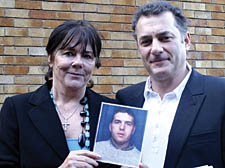|
|
 |
| |

Gwendoline Calvert with her partner Tony Flasher |
Victory for mum who fought to reveal truth about son’s cell death
Inquest blames ‘gross neglect’ by Pentonville officers after evidence of taped-over alarms
A MOTHER’S five-year battle for justice for her son finally ended on Monday when a jury ruled “gross neglect” by officers at Pentonville prison contributed to his death.
Paul Calvert, 40, died five years ago at the Holloway prison by hanging himself from a belt in his cell after pressing an emergency alarm.
An inquest at St Pancras Coroner’s Court, which ended on Monday, heard how guards at the jail were involved in a game of backgammon, unaware that Mr Calvert was dead in his cell, as emergency alarms had been taped over.
This week’s inquest was the second time the death had been investigated. An earlier verdict of misadventure was quashed by High Court judges in April. They ruled that jurors at the 2007 inquest should have been permitted to consider a verdict of neglect.
Speaking outside the inquest on Monday, Gwendoline Calvert was “delighted” to have won justice for her son after such a long fight.
“I’ve waited five years to hear the word neglect,” she said. “All I wanted was an admission that prison officers could have done more to save my son. I feel like a massive weight has been lifted off my shoulders.
“Last time it was like they had completely got away with it. But now I can finally put this to rest.”
During the week-long inquest, jurors heard how a catalogue of errors at the prison contributed to Mr Calvert’s death two days after he arrived at Pentonville following a breach of his bail conditions.
Crucially, details of self-harming during a previous sentence were never provided and he was allowed to keep his belt. Warnings about his fragile mental state were ignored.
The court heard compelling evidence from inmates about the “culture” of prison officers ignoring emergency alarms. Jurors were told the alarms were muted for at least 18 months prior to Mr Calvert’s death after officers found them “annoying”.
A post-mortem report was unable to establish the time of death but pathologist Kenneth Shorrock told jurors it is possible to resuscitate someone up to four minutes after they have hanged themselves. The court heard it takes about 46 seconds to walk from where the prison officers were to Mr Calvert’s cell, and around 17 seconds to run there in an emergency.
Medical staff who attempted to revive Mr Calvert told the inquest that when they reached him his body was “cold to the touch”.
Prisons Ombudsman Steve Payne, brought in to investigate the catalogue of failures that contributed to Mr Calvert’s death, published a list of recommendations, including a complete review of the cell bell system.
Speaking at the inquest, Nicholas Walmsley, who took over as operations manager three months after Mr Calvert’s death, admitted problems still exist five years later. He said: “Cell bells are not treated in the same way as general alarms, which are responded to immediately. Officers are not going to run to answer cell bell calls.”
Mr Walmsley said lessons had been learned from the death and changes at the prison include regular maintenance checks of cell bell panels and all officers being given a “fish knife” capable of cutting through leather. He said first-night prisoners were doubled up “where possible” and past medical information still came from prisoners.
A Prison Service spokesman said: “The National Offender Management Service will consider the inquest findings to see what lessons can be learned in addition to those already learned as a result of the first inquest and the investigation conducted by the Prisons and Probation Ombudsman.” |
 |
|
|
 |
| |
| |
|
 |
|